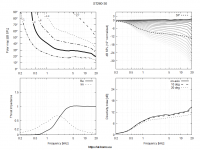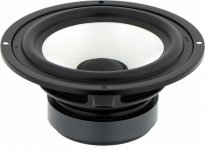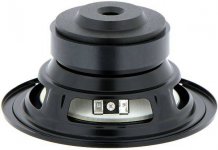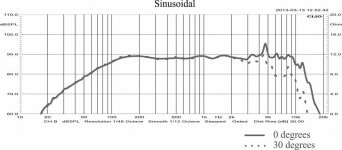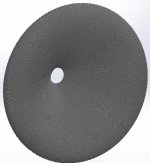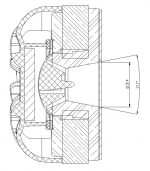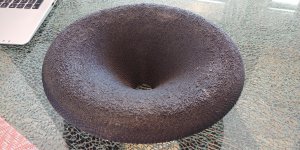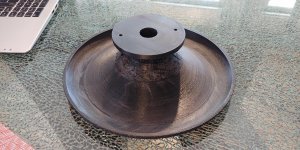As the QQ-S is specified at 255mm, here's a slightly smaller version (~252 x 80 mm): https://at-horns.eu/ext/ST260-30S.zip..I think I have my delta printer, Flsun qqs w/260mm round build area, ready to print this in one piece.
Incredible! Thank you very much for the modified models. The slicer software profiles I use are set to 260mm. I'll run some test circles to see where the limit is at before starting. Probably no real difference between the 260 vs 252 but the compulsion to max out my printer is strong.
Do we have Peerless DFM-2535R00-08 (smooth driver) exit angle?
According to Bateman: between 8 and 16°.
LineSource suggested 14°.
That Sandhorn shall be 1"?
That's an impressive hifi woofer considering the low price (€ 27).
Demodulation and symmetrical rings + copper "faraday cup" included.
That's an impressive hifi woofer considering the low price (€ 27).
Demodulation and symmetrical rings + copper "faraday cup" included.
Attachments
Yes 1inch. I was thinking about something like B&W Emphasis:
https://www.diyaudio.com/forums/subwoofers/371140-18cm-exponential-pipe.html#post6630734
https://www.diyaudio.com/forums/subwoofers/371140-18cm-exponential-pipe.html#post6630734
Trumpet. Do you know how Nautilus/Vivid Audio expo closed labirynth is calculated? n*Sd and freq?
Incredible! Thank you very much for the modified models. The slicer software profiles I use are set to 260mm. I'll run some test circles to see where the limit is at before starting. Probably no real difference between the 260 vs 252 but the compulsion to max out my printer is strong.
Can't figure out why the 260mm slicer profiles don't let me actually print 260mm.
I applied a knurl to the 252 and pressed go just a moment ago. Image has a moire effect that isn't part of the model. Looks like about a 24 hour print. My longest yet
Attachments
So the radial part of the phase plug is placed at for instans 12,8,4 o clock and not 12,3,6,9 as seen from the front view.
Isogeometric shape optimization of an acoustic horn using the teaching-learning-based optimization (TLBO) algorithm - ScienceDirect
Does this mean that we can model more efficiently and more precisely?
Does this mean that we can model more efficiently and more precisely?
I don't have the full article. Was directivity among the optimization criteria? So what were the results?
- Frankly, I think there remains very little to be desired regarding the simulation and optimization of axisymmetric devices, the way we can do it right now in ABEC. What's more to expect?
- Frankly, I think there remains very little to be desired regarding the simulation and optimization of axisymmetric devices, the way we can do it right now in ABEC. What's more to expect?
Last edited:
Single, dual and three-frequency optimization has been applied.
Three-frequency:
In the literature, no successful results were reported for three-frequency (400–600–800 Hz) optimization. Bängtsson et al.
(2003) reported failed results which were caused due to the mesh corruption when solving the three-frequency optimization
problem. In order to obtain the optimal solution, Bängtsson et al. (2003) refined the computational model to a much finer mesh
and performed the multi-frequency optimization. In the present study, three-frequency optimization was carried out
using the same mesh which was used for single-frequency optimization. Due to the inherent advantages of IGA, there was
no mesh corruption. The obtained optimal design boundary is shown in Fig. 16(a) and the corresponding reflection spectrum
is shown in Fig. 16(b). The obtained shape is very smooth with a low reflection coefficient for all the targeted frequencies.
Conclusion:
The combination of IGA and TLBO has been successfully applied to acoustic horn shape optimization. A Multi-patch
model was developed for the acoustic horn which was refined to 150 elements during analysis. The weak form of the
acoustic system was solved for pressure distribution and reflection coefficient, R, using IGA. The 8 control points describing
the design boundary were considered as the design variables which were modified to reduce the reflection coefficient,
R of the horn using the TLBO algorithm. The main advantages of TLBO are: (1) the absence of algorithm-specific tuning
parameters unlike other evolutionary optimization algorithms like GA and PSO; (2) no need for gradient computation, unlike
gradient-based optimization methods.
In single-frequency optimization, 4 cases (280, 400, 550 and 780 Hz) were considered. The obtained optimal values and
the reflection spectra were better than the FEA-based results reported in the literature. IGA-based shape optimization
produced better results than FEA-based shape optimization due to the use of higher-order basis functions which increase the
analysis accuracy combined with the increased flexibility of the boundary shape deformation through the use of NURBS
basis functions. In multi-frequency optimization, two and three-frequency optimization was performed.
The obtained optimal shapes were smooth and the reflection spectrum was much better than the FEM-based methods.
The three-frequency optimization was performed using the same mesh that was used in single-frequency optimization,
unlike earlier methods that used a much finer mesh to avoid mesh corruption leading to convergence issues.
The use of IGA benefited from increased accuracy per degree of freedom, geometry exactness, and convenient refinement
which are missing in conventional FEM. The developed platform is readily expandable to optimize 3D problems. However,
a considerable increase in computational cost and optimization time is expected. Some of the limitations of the proposed
approach are: (1) The possibility of the multiple optimum solutions makes identifying the best solution possible difficult,
(2) Increasing the number of design variables leads to wiggly optimum shapes which are not easy to manufacture.
In the future, we are planning to implement the proposed method to optimize other devices relying on acoustic wave propagation
and compare the results with those obtained using IGA-BEM.
Three-frequency:
In the literature, no successful results were reported for three-frequency (400–600–800 Hz) optimization. Bängtsson et al.
(2003) reported failed results which were caused due to the mesh corruption when solving the three-frequency optimization
problem. In order to obtain the optimal solution, Bängtsson et al. (2003) refined the computational model to a much finer mesh
and performed the multi-frequency optimization. In the present study, three-frequency optimization was carried out
using the same mesh which was used for single-frequency optimization. Due to the inherent advantages of IGA, there was
no mesh corruption. The obtained optimal design boundary is shown in Fig. 16(a) and the corresponding reflection spectrum
is shown in Fig. 16(b). The obtained shape is very smooth with a low reflection coefficient for all the targeted frequencies.
Conclusion:
The combination of IGA and TLBO has been successfully applied to acoustic horn shape optimization. A Multi-patch
model was developed for the acoustic horn which was refined to 150 elements during analysis. The weak form of the
acoustic system was solved for pressure distribution and reflection coefficient, R, using IGA. The 8 control points describing
the design boundary were considered as the design variables which were modified to reduce the reflection coefficient,
R of the horn using the TLBO algorithm. The main advantages of TLBO are: (1) the absence of algorithm-specific tuning
parameters unlike other evolutionary optimization algorithms like GA and PSO; (2) no need for gradient computation, unlike
gradient-based optimization methods.
In single-frequency optimization, 4 cases (280, 400, 550 and 780 Hz) were considered. The obtained optimal values and
the reflection spectra were better than the FEA-based results reported in the literature. IGA-based shape optimization
produced better results than FEA-based shape optimization due to the use of higher-order basis functions which increase the
analysis accuracy combined with the increased flexibility of the boundary shape deformation through the use of NURBS
basis functions. In multi-frequency optimization, two and three-frequency optimization was performed.
The obtained optimal shapes were smooth and the reflection spectrum was much better than the FEM-based methods.
The three-frequency optimization was performed using the same mesh that was used in single-frequency optimization,
unlike earlier methods that used a much finer mesh to avoid mesh corruption leading to convergence issues.
The use of IGA benefited from increased accuracy per degree of freedom, geometry exactness, and convenient refinement
which are missing in conventional FEM. The developed platform is readily expandable to optimize 3D problems. However,
a considerable increase in computational cost and optimization time is expected. Some of the limitations of the proposed
approach are: (1) The possibility of the multiple optimum solutions makes identifying the best solution possible difficult,
(2) Increasing the number of design variables leads to wiggly optimum shapes which are not easy to manufacture.
In the future, we are planning to implement the proposed method to optimize other devices relying on acoustic wave propagation
and compare the results with those obtained using IGA-BEM.
Attachments
Last edited:
35 hours later. Support structure didn't play very nice with the knurled texture. Overall looks pretty good. Should get some measurements done tomorrow.
ST260 Timelapse
ST260 Timelapse
Attachments
- Home
- Loudspeakers
- Multi-Way
- Acoustic Horn Design – The Easy Way (Ath4)
